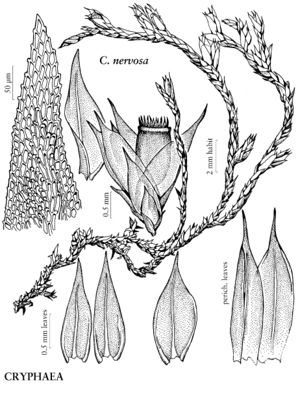Difference between revisions of "Cryphaea nervosa"
Linnaea 19: 211. 1846.
FNA>Volume Importer |
imported>Volume Importer |
||
| (6 intermediate revisions by 2 users not shown) | |||
| Line 12: | Line 12: | ||
}}{{Treatment/ID/Special_status | }}{{Treatment/ID/Special_status | ||
|code=F | |code=F | ||
| − | |label= | + | |label=Illustrated |
}} | }} | ||
| − | |basionyms={{Treatment/ID/ | + | |basionyms={{Treatment/ID/Basionym |
|name=Daltonia nervosa | |name=Daltonia nervosa | ||
|authority=Hooker & Wilson | |authority=Hooker & Wilson | ||
| + | |rank=species | ||
| + | |publication_title=J. Bot. (Hooker) | ||
| + | |publication_place=4: 420, plate 24, fig. B. 1842 | ||
}} | }} | ||
|synonyms= | |synonyms= | ||
| Line 33: | Line 36: | ||
|elevation=low to moderate elevations (0-1100 m) | |elevation=low to moderate elevations (0-1100 m) | ||
|distribution=Ala.;Fla.;Ga.;La.;Miss.;N.C.;S.C.;Tenn.;Tex. | |distribution=Ala.;Fla.;Ga.;La.;Miss.;N.C.;S.C.;Tenn.;Tex. | ||
| − | |discussion=<p>Cryphaea nervosa usually grows in more humid habitats than does C. glomerata; the two species are often intermingled. The narrowly pointed leaves of C. nervosa make it easy to recognize in the field. The costa is often so prominent that the leaves of dry plants appear to be plicate.</p> | + | |discussion=<p><i>Cryphaea nervosa</i> usually grows in more humid habitats than does <i>C. glomerata</i>; the two species are often intermingled. The narrowly pointed leaves of <i>C. nervosa</i> make it easy to recognize in the field. The costa is often so prominent that the leaves of dry plants appear to be plicate.</p> |
|tables= | |tables= | ||
|references= | |references= | ||
| Line 42: | Line 45: | ||
-->{{#Taxon: | -->{{#Taxon: | ||
name=Cryphaea nervosa | name=Cryphaea nervosa | ||
| − | |||
|authority=(Hooker & Wilson) Müller Hal. | |authority=(Hooker & Wilson) Müller Hal. | ||
|rank=species | |rank=species | ||
| Line 56: | Line 58: | ||
|publication title=Linnaea | |publication title=Linnaea | ||
|publication year=1846 | |publication year=1846 | ||
| − | |special status=Endemic; | + | |special status=Endemic;Illustrated |
| − | |source xml=https:// | + | |source xml=https://bitbucket.org/aafc-mbb/fna-data-curation/src/2e0870ddd59836b60bcf96646a41e87ea5a5943a/coarse_grained_fna_xml/V28/V28_920.xml |
|genus=Cryphaea | |genus=Cryphaea | ||
|species=Cryphaea nervosa | |species=Cryphaea nervosa | ||
Latest revision as of 21:39, 5 November 2020
Stems with branches short or elongate, simple. Leaves wide-spreading when moist, 1–1.2 mm; apex acuminate; costa percurrent or nearly so, not spurred, tip not 2-fid. Perichaetia with inner leaves 1.6–1.9 mm, awn usually distinct, denticulate, 1/5–1/4 length expanded portion of leaf. Capsule with peristome double; exostome teeth single; endostome segments irregularly linear. Calyptra subcucullate to cucullate. Spores papillose.
Phenology: Capsules mature Dec–Apr.
Habitat: Twigs, branches, trunks of trees, humid forests, swamp forests
Elevation: low to moderate elevations (0-1100 m)
Distribution

Ala., Fla., Ga., La., Miss., N.C., S.C., Tenn., Tex.
Discussion
Cryphaea nervosa usually grows in more humid habitats than does C. glomerata; the two species are often intermingled. The narrowly pointed leaves of C. nervosa make it easy to recognize in the field. The costa is often so prominent that the leaves of dry plants appear to be plicate.
Selected References
None.
